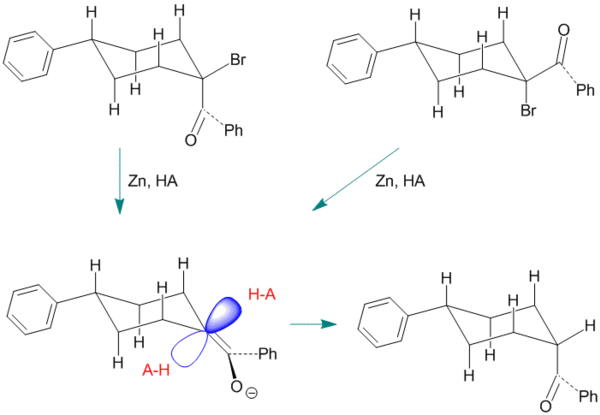In the stereochemistry of ketonization of enols and enolates, theory is provided explaining the diastereoselectivity observed in the conversion of certain enols and enolates into the corresponding ketone.
Introduction
Ketones and their corresponding enols are isomers, termed tautomers.
These are easily interconvertible. But simple enols are not generally
stable and of considerably higher energy than the corresponding ketones.
Nevertheless, a very large number of organic reactions proceed via enolic intermediates. Thus the behavior of enols is critical to an understanding of myriad organic reactions.
Many of these enols, formed in an organic reaction, a priori, can lead onward and afford two diastereomers on ketonization. If one knows the stereochemistry of ketonization of these enolic intermediates, then one can predict the stereochemistry of myriad organic reactions.
It was proposed in 1955 that the kinetic protonation of enolic species proceeds with an early transition state with the alpha carbon being close to sp2 hybridized. The proton donor selectively approaches the less hindered face of the enolate, thus leading to the less stable of two diastereomers. Reactions controlled in this fashion include:
- (a) decarboxylation of malonic acids
- (b) decarboxylation of beta-keto acids
- (c) the Michael addition of nucleophiles to unsaturated carbonyl compounds
- (d) the Birch reduction of enones
- (e) the deprotonation – protonation of carbonyl compounds
- (f) the dehalogenation of alpha-haloketones
- (f) the Norrish Type II Reaction
- and many more.
Kinetic or thermodynamic control
Protonation from the less hindered face of an enol leads to the less stable of two, a priori, diastereomers. In this example
there are two different reactions which afford the enol as a transient
intermediate. One is the treatment of an α-bromoketone with dilute HI in
acetone. The second is the reaction of an enol acetate with methyllithium. The first of the two reactions is an example of microscopic reversibility. This is the reverse of bromination of a ketone,
a reaction well-known to proceed via the enol as an intermediate. This
is an example with extreme stereoselectivity due to the severe steric
hindrance of an ethano-bridge.
With an acid catalyst as well as with a base catalyst such as sodium ethoxide a thermodynamic equilibrium is achieved. The diastereomer formed now has the acetyl group equatorial.
Figure 2. Equilibration of the Diastereomers via the Common Enol.
Unusual case of a phenyl pyridyl enol
Figure
3 show the ketonization results for the two Phenyl-Pyridyl
diastereomers. In the exo-pyridyl isomer on the left, the usual steric
hindrance control blocks protonation from above. That is, the phenyl
group is positioned directly above the enolic alpha carbon and
protonation must occur from below. In contrast, in the case of the endo
pyridyl isomer on the right, the basic pyridyl moiety proves capable of
picking up the proton first and then delivering it to the alpha-carbon
from this upper, hindered side. Results from intramolecular proton
delivery is the reverse of the common stereochemistry.
Figure 3. Two Phenyl-Pyridyl Enol Diastereomers.
A Typical example; an enol generated from an alpha-bromoketone
Figure 4. The Example of Ketonization of the Enol of 4-Phenyl-1-Benzoylcyclohexane.
In this example the enol intermediate is generated from either the
cis- or the trans-stereoisomer of 1-bromo-1-benzoyl-4-phenylcyclohexane
using zinc as the reagent. The endo proton approach is blocked by two
axial hydrogens. This example is somewhat more typical than those shown
earlier since the stereoselectivity is only in the range of 60 to 70 percent favoring formation of the (less stable) cis product.
![Example of the stereochemistry of kinetic protonation of an enol[6]](https://upload.wikimedia.org/wikipedia/commons/0/05/LinusLinder.gif)



